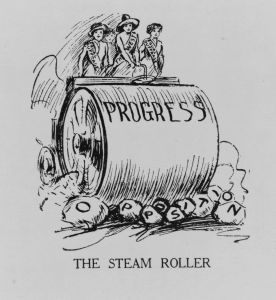The Women’s Suffrage Movement and its Contribution to American Feminist Thought and The Women’s Liberation Movement
Feminism in the Twentieth Century
This museum exhibit will showcase the effects the Women’s Suffrage Movement had on society in the 1920s, and the lasting effects it had on the remainder of the twentieth century into the present. These effects will primarily focus on the perception of gender and the role of women in America. This topic translates into a fascinating museum exhibition because of the wealth of literature and visuals created during the time period. With sources spanning from the late 1800s to a whole century later into the 1900s, one can see an undeniable connection between the Women’s Suffrage Movement and later equal rights movements, such as the sexual liberation movements of the 1920s and the 1960s. The exhibit will be organized chronologically, starting with the earliest dated sources and ending with the most recent. Several diverse sources will be elaborated on, because different sources from different time periods will show how the Women’s Suffrage Movement helped shape attitudes of feminism and equality in the United States. It will be clear to see how the feminists movements of the early 1900s impacted later advancements in women’s rights.

1917 political cartoon in support of the women’s suffrage movement.
Beginning with the acknowledgement of the Seneca Falls Convention in 1848, the exhibit will really start with the creation of the Women’s Suffrage Movement and feminist ideas in the late nineteenth century. Political unrest and female protest are featured in several sources from this time period so it will be necessary to explain the reasoning behind these behaviors and why they were essential to the beginnings of the suffrage movement. One of the questions answered by this section of the museum exhibit will be “Why did the Suffrage Movement start when it did?” Early Women’s Suffrage leaders felt disenfranchised by their lack of representation in government. Following the passing of the fifteenth amendment, women could see a more tangible future where one day they could secure the right to vote. The specification of only men having the right to vote sparked uproar for the women who now felt even more isolated from legislation. Prominent figures such as Elizabeth Cady Stanton, Lucretia Mott and Susan B. Anthony will have dedicated sections in this portion of the exhibit, highlighting their important roles in popularizing the movement.
All of this early feminist strife cumulates into the ratification of the Nineteenth Amendment. This will be one of the most heavily featured sources in the museum. It acts as the catalyst for every other point made in the museum exhibition. It’s role as the catalyst is because it was what gave women the initial right to vote, and the movement would inspire later feminists who wanted to organize in ways similar to the Suffragettes who proceeded them. With the amendment passing, the Women’s Suffrage Movement was a success, but not all was solved for women’s rights. From a governmental stand point, the right to vote had few immediate results in female representation. The focus of the exhibit shifts from the Women’s Suffrage Movement to broader feminist moments of the 1920s and into the great depression. Flappers, birth control, and female labor will all be topics that are touched on as the museum progresses. The specific emphasis on these subjects will be in comparison to and its relation back to the Women’s Suffrage Movement throughout the exhibit, however since other feminist movements are an imperative part of the topic, there will be a lengthy elaboration on each of these individual movements. After women gained the right to vote, there was still a present call for more agency in their day to day life. This Urgency predated the passing of the fifteenth amendment, and proved that it would not be going anywhere until more women stood up for themselves and demanded change. The sentiment that women felt like children in the present society, with little means to do anything independently, was largely held by women who felt oppressed by the pressure to present as “traditional”. Women expressing themselves as flappers was a display of defiance in the still very male-dominated country. They dressed the way they wanted to and used birth control to reclaim their sexuality. Gaining the right to vote was the first step in gaining personal freedoms.
As the United States progressed through the mid-twentieth century, women find themselves to become a more prevalent feature in the work force. Especially in the throes of World War II, there was an attitude of female empowerment as women had to work on the domestic front to aid the war effort, while men were off fighting overseas. Eventually World War II ends, and for the majority of the 1950s, women are expected to conform to their role as the devoted housewives and caretakers. Enter the 1960s, where second wave feminism is pushed front and center in the public eye. The Feminine Mystique is authored by Betty Friedan and Gloria Steinem becomes one of the most powerful voices for this feminist movement. It is in the 1960s and 70s that one can see the most pronounced evidence for the similarities between the Women’s Suffrage Movement and second wave feminism. After all, first wave feminism is another name for the Women’s Suffrage Movement and the surrounding feminist activity. Representation is once again a prevalent issue in the 1960s. Landmark moments such as Roe v. Wade, the failing of the Equal Rights Amendment, and the implementation of accessible birth control are all controversial decisions that rock the country in ways that mirror the events that occurred at the beginning of the century.
